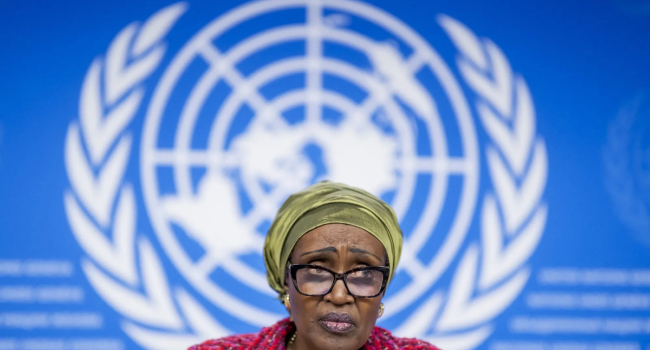
According to the Joint United Nations Programme on HIV/AIDS (UNAIDS), the distribution of condoms for the disease’s prevention in Nigeria has decreased by 55% from last December to March this year.
What the organization described as widespread disruptions to prevention, testing, and community-based programs across dozens of nations is illustrated by the figure, which was made public on Tuesday in the UNAIDS’ 2025 World AIDS Day report, Overcoming Disruption, Transforming the AIDS Response.
Due to the cuts to global programs since Donald Trump’s return to the White House, an uncountable number of additional people have died from AIDS, and 2.5 million have lost access to medication to stop the spread of HIV.
In a report released by UNAIDS, persistent funding shortfalls and the risky risks posed by the global HIV response have profound, long-lasting effects on the health and well-being of millions of people worldwide.
The impact was “immediate and severe” for countries like Nigeria, which is crucial for funding prevention infrastructure.
According to the report, UNAIDS’ community partners reported deaths of HIV-positive individuals who had been affected by local clinics and treatments, but it is unclear how many more deaths were brought on because data collection was still being done.
The United States, which contributed 75% of all global HIV funding, abruptly stopped all funding for HIV-related causes earlier in the year, according to UNAIDS, which was the catalyst for the global AIDS response.
Other donor countries have drastically reduced their foreign aid this year, including those in Europe, which have been pressed by Trump to instead increase defense spending.
Despite funding for some HIV programs that were previously funded by a U.S. program known as PEPFAR, UNAIDS, overall funding is still declining, putting in doubt 2030’s goals to end AIDS as a public health threat, according to UNAIDS.
READ MORE: UK to unveils tax-raising budget
Winnie Byanyima, the executive director of UNAIDS, stated to reporters in Geneva that her organization was working with at least 30 nations to reduce their dependence on international donors. She claimed that there are still significant challenges to overcome and that the funding gap cannot be closed right away.
According to the U.N. agency, there are 40.8 million HIV-positive people living, and 1.3 million new cases were identified in 2024.
In medical training and testing, the invention may lessen the need for cadavers and animals.
In October 2025, donors’ funding gaps reportedly caused 2.5 million people to lose access to the PrEP preventive HIV medication. According to Byanyima, Burundi’s distribution of preventive HIV medications decreased by 31%, 21%, and 64%.
Nearly half of women and adolescent girls reported interruptions to HIV prevention and treatment services in their communities, according to a survey conducted this year by UNAIDS and the ATHENA Network, a women’s rights organization.
In contrast to 2010, there were only 39% fewer people in the world who contracted HIV, with sub-Saharan Africa experiencing the greatest decline (56%).
However, an estimated 1.3 million [1 / 1.0 million / 1.7 million] people became HIV in 2023, which is more than the 370, 000 or fewer new infections that were targeted in 2025.
Condom programs have been defunded and social marketing initiatives have been reduced in many countries, but condom use continues to be the most cost-effective low-cost HIV prevention method. According to household survey data, condom use has decreased in recent years, particularly among young people between the ages of 15 and 24 and is not as frequent during sex with non-regular partners.
“A condom was used at the last sex by 36% of adults in eastern and southern Africa and 25% in western and central Africa.”
The HIV response is being hampered by a growing funding gap.
In 2023, low- and middle-income countries had funding for HIV programs worth almost US $ 9.8 billion (2019 United States dollars), which is almost US $ 9.9 billion less than the amount needed in 2025.
The total HIV resources available are at their lowest level in more than ten years, inflation-adjusted.
Eastern Europe, Central Asia, the Middle East, and North Africa are the countries that are preventing HIV epidemics the most.
The majority of HIV funding comes from domestic sources (roughly 59%), but stress exists for both domestic and international funding.
Domestic HIV funding decreased for the fourth year in a row in 2023, and international resources were almost 20% less than they did in 2013 when inflation was adjusted for inflation.
The amount of funding provided by bilateral donors has drastically decreased. Without continued, substantial funding from the United States Government and the Global Fund to Combat AIDS, Tuberculosis, and Malaria, the overall reductions in external HIV resources would be much greater.
HIV development assistance will continue to be a significant priority. The HIV response is still underfunded, despite societal enabler programs, and community-led initiatives.
“People from important populations are especially neglected,” according to the report, “even in areas where the vast majority of new HIV infections are spread by people from these populations.”
In contrast to the US $ 9.5 billion that will be required in 2025, USAID estimated that between US $ 1.8 billion and US $ 2.4 billion were available for primary prevention programs in low- and middle-income countries in 2023.
UNAIDS urged world leaders to reiterate their political and financial commitments to ending AIDS, citing commitments made at the most recent G20 summit in South Africa.
Source: Channels TV

Leave a Reply